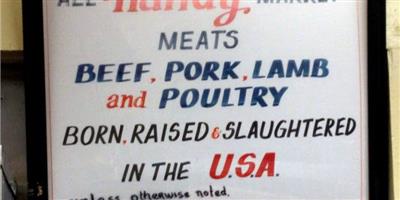Originally posted Nov. 2, 2016 on AgEconMT.com
After my most recent post that attempts to illustrate a market-based explanation for the recent declines in feeder cattle prices, there was an interesting discussion about how factors such as Brazilian beef imports and country-of-origin labeling (or lack thereof, since the law that required beef processors to label the country from where the beef product originated was repealed in 2015) might also play a role in determining prices. Especially their role in the recent price decline.
First, I wanted to look at the relationship between Brazilian imports of beef products and live animals and at least superficially assess whether there appears to be a “negative” or “inverse” relationship between the level of those imports and feeder cattle prices. Intuitively, one would expect to see a negative relationship because if US processors are able to import Brazilian beef, then their demand for US beef would decrease, which would then result in lower prices for US feeder cattle (i.e., processors substitute Brazilian beef for US beef, which would lower their willingness to pay for US cattle).
I gathered historical Brazilian beef and cattle import data from the USDA Foreign Agricultural Service’s Global Agricultural Trade System database, US red meat production data from the USDA Economics Research Service, and feeder cattle prices for Montana from beefbasis.com. Lastly, I calculated the proportion of total US red meat sales is represented by imported Brazilian red meat. Here is what the data look like:
Brazilian Beef Imports, Montana Feeder Cattle Prices, and US Red Meat Sales
Here are my thoughts after assessing the data:
- Imports of Brazilian live animals has remained relatively flat.
- There appears to be a positive relationship between Brazilian red meat imports and Montana feeder cattle prices. This is not the negative relationship that would be expected US processors and packagers substituted Brazilian beef for US beef.
- The positive relationship between imports and US feeder cattle prices suggests that there is likely other factors that concurrently driving packagers’ demand for both imported and domestic meat.
- Brazilian beef represents less than 0.5{e1c719bd29d6bb84a792d8ffcb03a61a093900316f2da3efbd39b86f03d248b8} of US red meat production over the past seven years, suggesting a likely very small (if any) impact of Brazilian imports on US feeder cattle prices.
The relationship between the repeal of the country-of-origin labeling regulation and cattle prices is even more difficult to assess. At least two studies (here’s the link to the first study and the second study) have shown that COOL would have adverse impacts on both US beef producers and consumers because the legislation would be associated with higher input costs for packagers (i.e., traceability and labeling), which would be passed on up and down the beef marketing channel. However, both studies estimated that feeder cattle producers would be less impacted than others in the production and marketing channel, and only slightly more affected than beef consumers.
While it might arguably be naive to assume that an opposite, positive effect on US beef producers is expected as a result of the COOL repeal, it is perhaps more difficult to conclude that the adverse effects found to be associated with COOL would be somehow compounded by its cancellation. Of course, the cattle and beef industries have likely changed since 2002 when the COOL provision was enacted and additional economic analysis would be necessary to accurately identify and estimate the effects.
(Photo by gruntzooki is licensed under CC BY 4.0)
Dr. Anton Bekkerman is an associate professor in the Department of Agricultural Economics and Economics at Montana State University, joining the faculty in 2009 after completing his PhD at North Carolina State University. Bekkerman's primary areas of research are grain marketing, basis and price forecast modeling, understanding how grain prices are affected by changes in supply chain infrastructures and quality demands, and analyzing the economic trade-offs of adopting alternative dryland cropping systems in Montana. One of his current projects is an investigation of how new grain loading technologies are affecting prices that Montana farmers receive for their wheat. Bekkerman is also examining the economic impacts that Montana's rapidly expanding dry pulse industry will have on the state's crop industry. Although Bekkerman grew up on the east coast, he has recently made a small step toward production agricultural after acquiring three backyard chickens.


